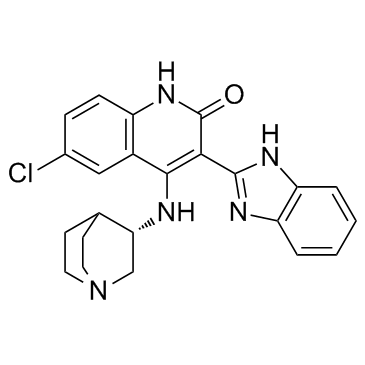CHIR-124

CHIR-124 structure
|
Common Name | CHIR-124 | ||
|---|---|---|---|---|
| CAS Number | 405168-58-3 | Molecular Weight | 419.907 | |
| Density | 1.5±0.1 g/cm3 | Boiling Point | N/A | |
| Molecular Formula | C23H22ClN5O | Melting Point | N/A | |
| MSDS | N/A | Flash Point | N/A | |
Use of CHIR-124CHIR-124 is a potent and selective Chk1 inhibitor with IC50 of 0.3 nM, and also potently targets PDGFR and FLT3 with IC50s of 6.6 nM and 5.8 nM. |
| Name | 4-[[(3S)-1-azabicyclo[2.2.2]octan-3-yl]amino]-6-chloro-3-(1,3-dihydrobenzimidazol-2-ylidene)quinolin-2-one |
|---|---|
| Synonym | More Synonyms |
| Description | CHIR-124 is a potent and selective Chk1 inhibitor with IC50 of 0.3 nM, and also potently targets PDGFR and FLT3 with IC50s of 6.6 nM and 5.8 nM. |
|---|---|
| Related Catalog | |
| Target |
Chk1:0.3 nM (IC50) Chk2:697.4 nM (IC50) PDGFR:6.6 nM (IC50) FLT3:5.8 nM (IC50) Cdk4/cyclin D:2.05 μM (IC50) CDC2/cyclin B:0.5057 μM (IC50) Cdk2/cyclin A:0.1911 μM (IC50) bFGFR:2.01 μM (IC50) FGFR3:1.29 μM (IC50) VEGFR2 FLK1:0.5779 μM (IC50) VEGFR1 FLT1:0.4636 μM (IC50) PKCα:0.58 μM (IC50) PKAβ I:2.25 μM (IC50) PKCβ II:0.58 μM (IC50) PKCγ:0.11 μM (IC50) ERK2:4.31 μM (IC50) PKA:0.1031 μM (IC50) GSK3:0.0233 μM (IC50) |
| In Vitro | CHIR-124 is 500- to 5,000-fold less active against other cell cycle kinases, such as cyclin-dependent kinase 2/cyclin A (0.19 μM), cdc2/cyclin B (0.51 μM), and cyclin-dependent kinase 4/cyclin D (2.1 μM). CHIR-124 (≥0.9 nM) in combination with SN-38 (≥0.42 nM) causes significant synergy or >10% deviation from additivity in human cancer cell lines expressing mutant p53, and these values overlap and fall below the IC50s for SN-38 (1.2×10-7 M) and CHIR-124 (2.2×10-7 M), respectively. Moreover, CHIR-124 (100 nM) abrogates the SN-38-induced S and G2-M phase cell cycle checkpoints. CHIR-124 (200 nM) leads to a 2.5-fold elevated level of cdc25A above that of the untreated HCT116 p53−/− cells. The down-regulation of cdc25A induced by SN-38 is completely restored by concurrent or sequential treatment with CHIR-124, proving that CHIR-124 inhibits the Chk1-mediated destruction of cdc25A in whole cells[1]. CHIR-124 occupies the ATP-binding site, inhibits Chk1 (IC50, 0.3 nM) 2,000-fold more potently than Chk2 (IC50, 0.7 μM)[2]. |
| In Vivo | CHIR-124 (10 or 20 mg/kg, p.o.) does not have a significant effect on tumor growth when compared with the vehicle-treated group, but it potentiates the growth inhibitory effect of CPT-11 in a human breast carcinoma xenograft model. The potentiation of the tumor growth inhibitory effect of CPT-11 by CHIR-124 is associated with an increase in apoptosis induction in the tumors. CHIR-124 reverses the suppression of phospho-H3 staining induced by CPT-11, indicating abrogation of the G2-M checkpoint by CHIR-124[1]. |
| Kinase Assay | For the CHK1 assay, the kinase domain is expressed in Sf9 insect cells, and a biotinylated cdc25c peptide containing the consensus Chk1/Chk2 phosphorylation site (*)(biotin-[AHX]SGSGS*GLYRSPSMP-ENLNRPR[CONH2]) is used as the substrate. A dilution series of CHIR-124 is mixed with a kinase reaction buffer containing a final concentration of 30 mM Tris-HCl (pH 7.5), 10 mM MgCl2, 2 mM DTT, 4 mM EDTA, 25 mM β-glycerophosphate, 5 mM MnCl2, 0.01% bovine serum albumin, 1.35 nM CHK1 kinase domain, 0.5 μM peptide substrate, and 1 μM unlabeled ATP, plus 5 nM 33P γ-labeled ATP (specific activity =2,000 Ci/mmol). Reactions and detection of the phosphate transfer are carried out by a radioactive method. |
| Animal Admin | Severe combined immunodeficient mice harboring MDA-MD-435 tumor xenografts are randomized into the following treatment groups of 10: vehicle (captisol) alone, 5 mg/kg CPT-11, 10 mg/kg CHIR-124, 20 mg/kg CHIR-124, 5 mg/kg CPT-11 plus 10 mg/kg CHIR-124, or 5 mg/kg CPT-11 plus 20 mg/kg CHIR-124. Treatment is initiated on the day after randomization (day 1). CPT-11 is given i.p. daily (four times daily) ×5 on days 1 to 5, whereas CHIR-124 is given orally four times daily ×6 on days 2 to 7 in captisol. Percent tumor growth inhibition is defined as % T/C, where T = the treatment group mean, and C = the control group mean. In a similar study, tumors harvested from mice sacrificed on day 4 of treatment are examined for apoptosis by terminal deoxynucleotidyl transferase-mediated nick-end labeling staining and for mitotic index by immunofluorescence labeling with phospho-histone H3 antibody. |
| References |
| Density | 1.5±0.1 g/cm3 |
|---|---|
| Molecular Formula | C23H22ClN5O |
| Molecular Weight | 419.907 |
| Exact Mass | 419.151276 |
| PSA | 76.28000 |
| LogP | 3.86 |
| Index of Refraction | 1.750 |
| Storage condition | -20℃ |
| 4-[(3S)-1-azabicyclo[2.2.2]oct-3-ylamino]-3-(1H-benzimidazol-2-yl)-6-chloroquinolin-2-ol |
| 2(1H)-Quinolinone, 4-[(3S)-1-azabicyclo[2.2.2]oct-3-ylamino]-3-(1H-benzimidazol-2-yl)-6-chloro- |
| 4-[(3S)-1-Azabicyclo[2.2.2]oct-3-ylamino]-3-(1H-benzimidazol-2-yl)-6-chloro-2(1H)-quinolinone |
| 4-[(3s)-1-Azabicyclo[2.2.2]oct-3-Ylamino]-3-(1h-Benzimidazol-2-Yl)-6-Chloroquinolin-2(1h)-One |
| 2-quinolinol, 4-[(3S)-1-azabicyclo[2.2.2]oct-3-ylamino]-3-(1H-benzimidazol-2-yl)-6-chloro- |
| pound not CHIR124 pound not CHIR 124 |
| CHIR-124 |
| UNII-5K64W8EU3E |